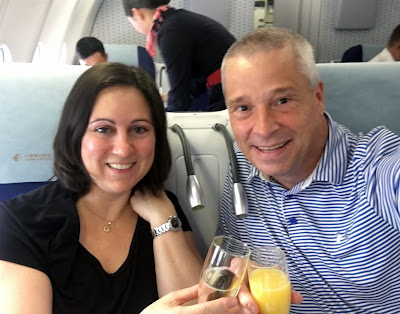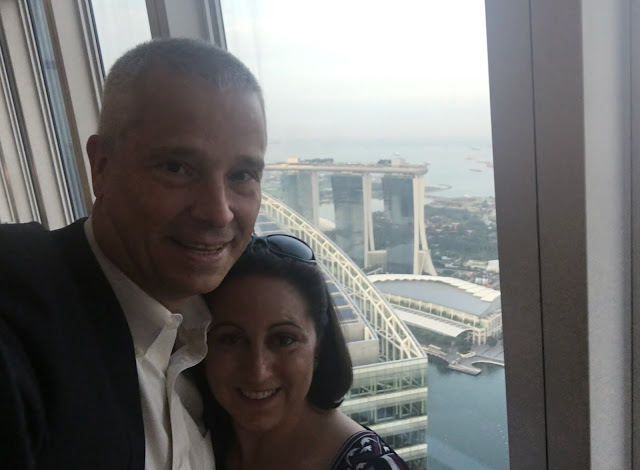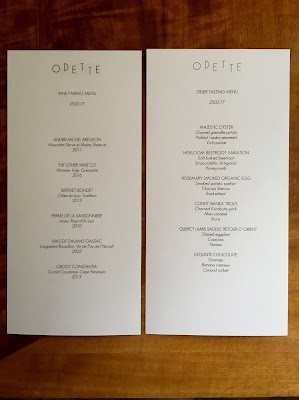 |
| Don't worry that's Steve's on the wagon - he has a mimosa! |
The next morning we quickly realize we're no longer in Tokyo. We're enter the hotel elevator and the person inside says hello. Then we stop at another floor and a couple gets on, and also starts talking with us. That never happens in Tokyo - it's practically a rule that no one speaks on the elevator.
After breakfast we walk around and take the MRT (subway) to The Arcade, which hosts multiple money exchange facilities, among other shops and restaurants. Downtown Singapore is set up so you can do a lot of walking inside and underground, so you can stay in air conditioning. It's not restricting though, because many times there are openings to the outside or there's a courtyard so you see sunlight and get fresh air. (We realize this after we wander at street level for about 15 minutes in the heat and humidity, and only see one other couple holding a large paper map, obviously also tourists - everyone else knows to limit their exposure to the outside.) They air condition here like they do in the southeast US - as cold as possible! Unlike Japan, where I keep sweating when I enter a building because the thermostat is set at around 78 degrees. In Singapore it feels like 68. It's very refreshing, and reminds me of home!
Our next stop is to a nearby quilt shop, Quilts and Friends. It's at The Adelphi building at 1 Coleman St, #03-09. Steve figures out the numbering system first - the 03 refers to the floor level (third floor) and the 09 is the shop number. Many businesses are inside a mall/department store type building, so they use this address arrangement to help you find places faster. It's a small store, and expensive - fabrics on the bolt start at $15 USD a meter. They have a back room where a class is taking place while I'm there, and a limited amount of notions. Once again, I'm distracted by the fabric and I forget to take pictures. Though I don't buy anything it's nice being in a "typical" quilting store again.
 |
| Arab Street |
 |
| Steve contemplating the choices |
 |
| one of the many rug stores |
 |
| I finally remember to take a picture! Here's one side with fabrics on the bolt and some clothing... |
 |
| the front sign |
 |
| ...and here's the other side with more batik clothing. |
At 91 Arab St, Toko Aljunied I buy some sarongs, including one that has a "quilting batik" look. I haven't decided whether or not I'll cut it up for a quilt. He has many different quality levels of batiks, including completely handmade items. Unfortunately (or fortunately for my wallet) I just didn't like the patterns or colors enough to purchase any of them, though I love the idea of a completely handmade batik fabric.
 |
| my purchases at Toko Aljunied |
 |
| I just remembered to take a picture of the sign. |
While we wander the street, for the first time I see, in person, a woman wearing a full burka. I may have committed a faux pas - I'm wearing long shorts, but we're in the Muslim part of the city. If I thought about it I would have put on pants, even though no one says or does anything. I see a few other women wearing shorts or skirts. However, most of the women are in pants and headscarves (she was the only burka I saw).
 |
| I think Steve picks this cafe because his shirt coordinates with the table cloth. |
Our final stop in this area is Kiah's Gallery at 71 Sultan Gate, right before the entrance to the Malay Heritage Centre, a few blocks from Arab St. She sells handmade batik clothing for men and women, and can do custom orders and adjustments. Unfortunately her available items are not in the style I prefer or too small (she only has one size of each item). The owner and her husband are wonderful to talk with as I look at the items. One of the nice aspects of Singapore is English being the primary language (though there are four official languages). All the signs, menus, etc are in English, and everyone speaks it, making it much easier on us. It also feels very multicultural in Singapore. There's much more variety in the nationalities of people than in Japan. You also see many different foreign stores here. Just riding down the street I notice US (Sephora), British (Marks and Spencer, Lush), even Japanese (Muji, Uniqlo, Takashimaya) shops here.
 |
| Not many people are able to look DOWN at the Marina Bay Sands observation deck! |
Later this evening we take advantage of a reciprocal club agreement between the Tokyo American Club and the Tower Club Singapore. Why pay $18/ person to go to the Marina Bay Sands observation platform when we can go 8 stories higher for free, and enjoy a drink at happy hour prices? (Total coincidence - we weren't aware of happy hour at the time.) We enjoy sitting and checking out the 360 degree view, and of course we can't resist trying to take a selfie with Marina Bay Sands in the background.
 |
| View #1 of Singapore |
 |
| View #2 of Singapore |
 |
| View #3 of Singapore |
 |
| The light makes it difficult to see us and the scenery. Back to the instruction manual! |
We plan for one "nice" dinner while in Singapore, and I'm able to make reservations at Odette, rated as #9 for Asia's Best Restaurants, #86 for World's Best and has two Michelin stars. We think it's our favorite of the Michelin star restaurants we've visited.
 |
| How sweet - the restaurant is named after the chef's grandmother. |
 |
| We're sent home with copies of the menus and a jar of jam. |
We have two tasting menus to choose from, and one of them is all Japanese items. That makes it easy for us to pick the other one. Surprise, surprise, we also pick the accompanying wine pairings, too. Unlike L'Effervescence, It's more than just a taste of wine per course.
 |
| We found it! And they don't give away our reservation because we're late! |
 |
| The kitchen is visible from every seat in the dining room. |
 |
| Pretty presentation! |
 |
| I love the colors in this dish! Who knew beets could taste so good? |
 |
| Foam may be overdone, but I always like smoke at my table! |
 |
| lots of lamb |
 |
| the (additional) cheese course |
 |
| Cucumber sorbet with lemon and basil - palate cleanser before dessert! |
 |
| Ask Steve when the actual date is - see how long it takes him to answer! |
As one of the dessert courses, we celebrate our anniversary (again). It's really close this time, though!















































